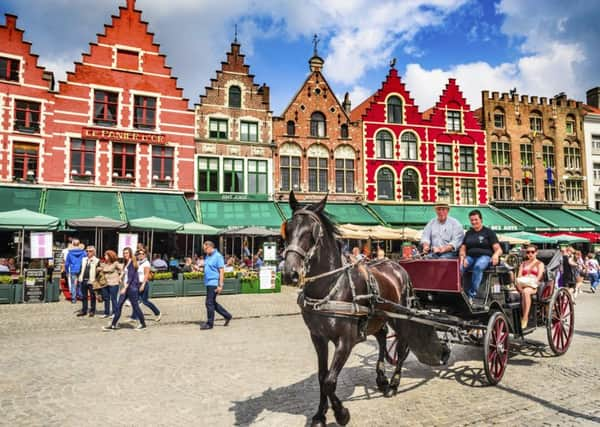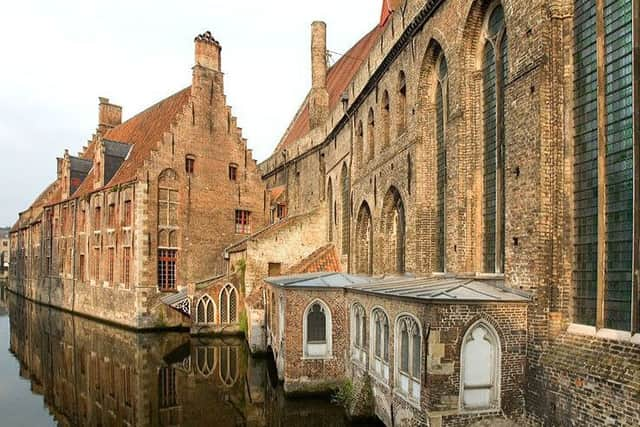Travel: All is revealed about a brush with Bruges


The West Flanders capital of Bruges is a small, foot-friendly city of crystalline light, world-famous art and history in every cobblestone. It’s a place of special pilgrimage for painters, and I spent a month there as an artists’ model. The atelier in which I modelled specialised in the style of Old Masters – such as 15th century Flemish artist Hans Memling and Netherlander Jan van Eyck – and the job gave me time to explore the art and some of the hidden corners of the city.
A herb garden grows tucked away in the grounds of one of the oldest hospital buildings in Europe. St Janshospitaal Museum is a fascinating place, revealing the medieval juxtaposition of caring for both body and soul. Be sure to see the apothecary’s shop, stocked with dried herbs from the garden. Enter the chapel to see six masterpieces by Memling, taking time to enjoy how well he captured the rich texture of velvet, silk and fur, an open mixture of piety and wealth, in his paintings. The former hospital ward displays objects including sedan chairs for the injured, surgical instruments (many of which don’t look different from those used today) and artwork from the hospital – which often, eerily, displays proud doctors standing over their limp or dissected patients.
Advertisement
Hide AdThe Groeninge Museum houses priceless works of art, notably paintings by Van Eyck. His treatment of pigments was revolutionary and people who viewed his paintings for the first time thought he was an alchemist or necromancer – they couldn’t believe how real his paintings looked. Make sure you spend time looking at his painting Madonna With Canon Van Der Paele. There is much more to see, and though it’s not a large museum, take your time over the painting styles that transformed the history of art.


Walking around Bruges, you’d find it difficult to miss two of its most scenic features: the central market square, or Burg, and the canals which give Bruges its nickname “Venice of the North”. A good walk, or canal tour, shows how closely protected the formerly walled city was back in the 13th century, with four of the eight gates for controlling waterway traffic still standing today. Combine both sights by taking a canal tour from Burg Square, or tour the city in another traditional way, by Pardetraam or horse-drawn carriage. The clip-clop of horses’ hooves combines with chimes from 47 musical bells in the carillon of the 83-metre tall Belfort in the centre of the Burg. It’s musical and magical, and if you fancy a walk up the 366 steps, you can enjoy some extraordinary views.
By Minnewater Park, in the southern part of Bruges, is the mysterious and peaceful béguinage of Ten Wijngaerde (the “winegarden” or vineyard). A béguine was a woman who devoted her time to the needs of the poor and sick, and practised religious devotion but was not formally committed to monastic life and could leave (usually, to marry) at any time. These lay monastic communities provided a place of retreat and contemplation for women, particularly in the 13th to 16th centuries in the Low Countries. The béguinage in Bruges was founded around 1244. It has been a Benedictine convent since 1927, and tourists are welcome to – quietly – view the grounds.
The lace and linen trade once formed the financial centre of Flanders, making use of the finest threads and emulating ornate, curving patterns from Italy. Learn about the history of bobbin lacemaking in the Kantcentrum, the Lace Museum of Bruges. Lace manufacturers Rococo (http://www.rococobrugge.be) has antique lace pieces for sale and a great historical knowledge, as its owner, Mieke Brack, is descended from a family of lace-makers.
If it’s a sunny day, rent a bicycle from a small local place (such as Eric Popelier in the city centre) and follow the flat, easy path along the Damme Canal all the way to Sluis, in the Netherlands. You’ll be cycling from one country into another, passing windmills, fishermen tucked into the reed beds on either side of the canal, lots of water birds and beautifully hypnotic rows of Dutch elm trees that make the light flicker past like an old film-reel as you pedal. Before you go, stock up on cheese and bread at one of the many bakeries in Bruges.


There is a great deal of traditional cuisine, from Belgian waffles and frites that you can buy on almost any corner of the city, to waterzooi, the thick, creamy Flemish stew of either fish or chicken. Belgian beer is famous too – try Trappist ales in particular, but don’t pour out the whole bottle, or the sediment that should stay resting on the bottom will end up in your glass. I particularly like Bistro Terrastje on Genthof 45, which has lovely ales, stews and live music with friendly owners and clientele. Their opening hours are changeable, so you need a bit of luck as well as the address. A more decadent approach to Belgian beer can be found at Den Dyjver, where beers are matched with each course in high style. Beware: ordering tap water is a big no-no, even though the water is safe to drink. It’s not only frowned upon, but rejected outright. Save your money: good local beer is usually cheaper than bottled water.
Advertisement
Hide AdThere are places to stay to suit every budget: as an impoverished artists’ model, I was packed off to a guest house whose landlady rented out her own bedroom when the other rooms were full. For a more luxurious stay, the centrally located Martin’s Relais Oud Huis has modern facilities set in a gorgeous period interior. Hotel Die Swaene was voted one of the top 100 hotels in the world by Condé Nast Travel. It’s small and romantic, with gilded furnishings, heavy drapes, an indoor swimming pool and a sauna. Both are noted for their delicious breakfasts.
Tell people you’re heading to Bruges, and they’ll all ask if you’ve seen the film In Bruges (2006). Darkly comical, the film is worth seeing, but it’s not for the young or squeamish. Featuring Colin Farrell as a hit man-on-the run, the Oscar-nominated film brings a purposely absurd level of violence and bloodshed to the charming, faultless backdrop of Bruges. There’s even a free “In Bruges” walking tour available – be sure to tip your guide.
• The Naked Muse by Kelley Swain is published by Valley Press, £8.99 http://www.valleypressuk.com/book/66/the_naked_muse